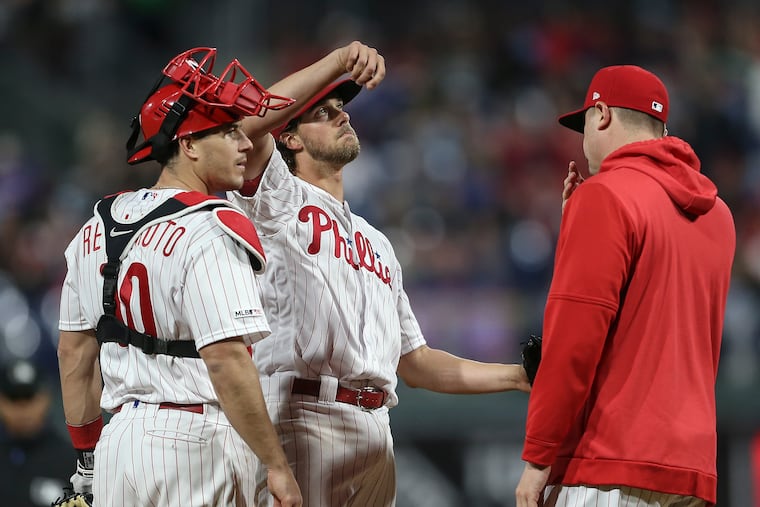Why the Phillies believe starting rotation’s three-week run of success is sustainable
It's hard to predict what makes the rotation successful night in and night out.

Even after Aaron Nola and Jerad Eickhoff began the week by throwing consecutive duds, Phillies starting pitchers still entered Wednesday night with a combined 2.65 ERA in the last 18 games. It’s hardly coincidental that the team went 12-6 during that stretch.
The question now, and especially after Nola and Eickhoff got roughed up by the Brewers, is whether the rotation's recent roll is sustainable.
"We're not smart enough to know exactly what each guy is going to do every time out," general manager Matt Klentak said this week. "But we do trust in the group of them. We trust in their talent. And we trust in their depth."
Depth is critical, of course. The Phillies have already used seven starters this season, three fewer than their total from all of last year, when they had five pitchers make at least 24 starts.
Given the preponderance of injuries across the game -- and pitching attrition, in particular -- that’s both unusual and unlikely to happen again, which is why the Phillies are hesitant to turn either Vince Velasquez or Nick Pivetta into a reliever when they return from the injured list and triple A, respectively.
But what makes the collective performance of the Phillies rotation even more difficult to predict is the way that the current starters have been recording outs, namely by getting weak contact early in counts rather than piling up strikeouts and swings and misses.
As a group, Phillies starters had the third-highest contact rate (80.3 percent) of any rotation in baseball entering Jake Arrieta's start against the Brewers, trailing only the Mariners (82.1) and A's (80.9). They also ranked 23rd in strikeouts per nine innings (7.99).
Arrieta is a pitch-to-contact sinkerballer; Eickhoff and rookie lefty Cole Irvin rely on changing speeds and mixing pitches to make up for fastballs that only graze 90-91 mph. Zach Eflin has had great success with getting quick outs on the ground, his strikeout rate falling from 8.6 per nine innings last season to 6.7 per nine so far this year.
Pitching coach Chris Young knows that there will be times when all of the contact being made by opposing hitters won’t be so weak. But he also believes each of the Phillies starters is capable of getting more swings and misses than he has thus far this season, and really, that’s what might determine the rotation’s long-term success.
“The strikeout is in vogue right now, obviously, and I love that our group can go get strikeouts,” Young said. “I think some of the strikeout numbers aren’t there due to the contact early. I know the hard contact against has been in our favor most of the year. I think that’s something we can continue. But I think there’s going to be stretches where we run through some strikeouts, too.”
Health permitting, Nola and Arrieta won’t relinquish their spots in the rotation. Eflin appears to have cemented his with a brilliant three-start stretch in which he has allowed two runs on 15 hits and two walks in 25 innings for a 0.72 ERA. He’s the only pitcher in the majors this season with two complete games and only the fourth Phillies pitcher since 2000 with more than one complete game before the end of May.
It's premature to gauge the staying power of Eickhoff and Irvin. The latter, in particular, has made all of one start since being called up from triple-A Lehigh Valley, and he was terrific in Kansas City last Sunday.
But as the replacements for Pivetta and Velasquez, Eickhoff and Irvin have the slimmest margins for error, both because of their pitching styles and the potential for alternatives.
Even if Pivetta and Velasquez prove not to be any more effective, the Phillies figure to be on the lookout for pitching upgrades in both the rotation and the bullpen before the July 31 trade deadline.
“We never know exactly which five are going to be in the rotation at any one point and who’s going to be doing well and who may be struggling,” Klentak said. “But we trust in the organization’s ability to produce pitchers that can come up and contribute.”